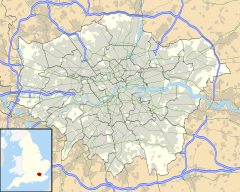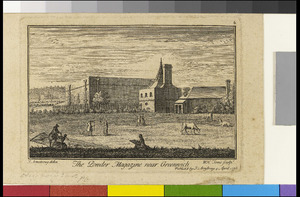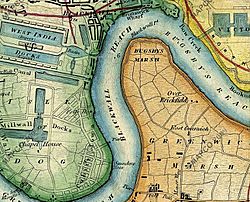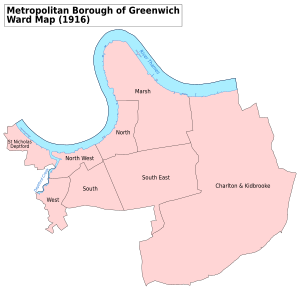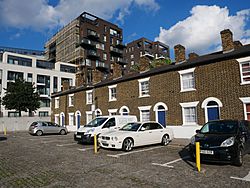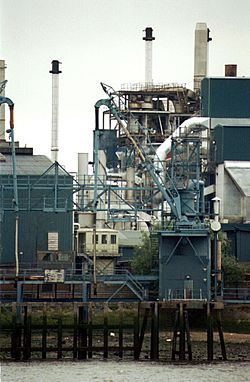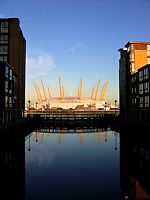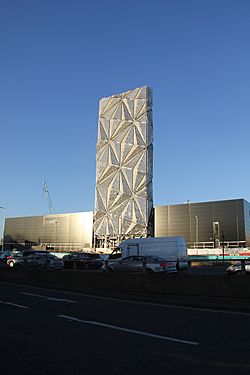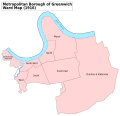Greenwich Peninsula facts for kids
Quick facts for kids Greenwich Peninsula |
|
|---|---|
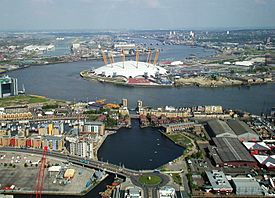 Greenwich Peninsula, seen from 1 Canada Square in 2000. The Millennium Dome (now The O2) is in the middle. |
|
| OS grid reference | TQ392796 |
| London borough | |
| Ceremonial county | Greater London |
| Region | |
| Country | England |
| Sovereign state | United Kingdom |
| Post town | LONDON |
| Postcode district | SE10 |
| Dialling code | 020 |
| Police | Metropolitan |
| Fire | London |
| Ambulance | London |
| EU Parliament | London |
| UK Parliament |
|
| London Assembly |
|
| Website | http://www.greenwichpeninsula.co.uk |
The Greenwich Peninsula is a cool area in Greenwich, located in South East London, England. It's almost completely surrounded by a big bend in the Thames. To the west is the Isle of Dogs, and to the east is Silvertown. South of the peninsula is the rest of Greenwich, and to the south-east is Charlton.
This area used to be called Greenwich Marshes or Bugsby's Marshes. In the 1800s, it became known as East Greenwich as it grew. More recently, people started calling it North Greenwich because of the Underground station there. Don't mix this up with another place called North Greenwich on the Isle of Dogs! The very tip of the peninsula by the river is called Blackwall Point. This is why some people in the late 1900s sometimes called it the Blackwall Peninsula.
Today, the most famous landmark is The Dome, now known as The O2. The southern entrance to the Blackwall Tunnel is also here. The area is now being completely transformed with lots of new homes, offices, schools, and parks. Ravensbourne University London, a university for media and design, was built here in 2010, right next to The O2.
Contents
Greenwich Peninsula's Past
In the 1500s, engineers from the Netherlands helped drain the peninsula. This made the land useful for grazing animals. In the 1600s, Blackwall Point, the northern tip of the peninsula, became famous for a grim reason. The bodies of pirates were sometimes hung there in cages. This was meant to scare off other people who might think about becoming pirates.
Around the 1690s, the government's Board of Ordnance built a gunpowder magazine on the west side of the peninsula. This was a place to store gunpowder. It started operating in 1695 and was the main storage spot for new gunpowder. There was also a wharf (a place to load and unload boats), a testing house, and homes for the staff.
However, from the early 1700s, local people started asking Parliament to move the dangerous gunpowder away. This led to new Royal Gunpowder Magazines being built further down the river at Purfleet. They opened in 1765. By 1771, gunpowder was no longer stored at Greenwich, but the old buildings stayed for many years.
The peninsula slowly became a place for factories and industries starting in the early 1800s. In 1857, there was a plan for a huge dock covering most of the peninsula, but it never happened. Early businesses made heavy guns, chemicals, submarine cables, and iron boats. Henry Bessemer built a steel works in the early 1860s to supply London's shipbuilding industry. But it closed because demand dropped after a financial problem in 1866.
Later, there were oil mills, shipbuilding yards (like for the famous clipper ships Blackadder and Hallowe'en built in 1870), and factories making boilers, Portland cement, and linoleum. Bessemer's old steel works became the Victoria linoleum works. The South Metropolitan Gas company also built its giant East Greenwich Gas Works here. In the early 1900s, Delta Metals made bronze, and other factories made asbestos and animal feed.
For over 100 years, the peninsula was dominated by the gasworks. This factory mainly produced town gas, also called coal gas. The gasworks grew to be 240 acres (about 1 square kilometer), making it the largest in Europe. It also produced coke, tar, and chemicals. The site had its own railway system connected to the main line near Charlton. It also had a large jetty to unload coal and load coke.
There were two massive gas holders, which are huge tanks for storing gas. One was originally the largest in the world. It was damaged in the Silvertown explosion in 1917 and again by a bomb in 1978. The plant first made gas from coal, then from oil in the 1960s. At its busiest in the mid-1960s, it produced a huge amount of gas every day. This was thought to be the most from any single site in the world. But when natural gas was found in the North Sea, the gasworks became old-fashioned.
On the eastern side of the river was Blackwall Point Power Station. The original station from the 1890s was replaced in the 1950s. The new station stopped working around 1981. On the western side, a large area that used to be the Victoria linoleum works became the Victoria Deep Water Terminal in 1966. This handled container ships.
At the southwest end of the peninsula, Enderby's Wharf was home to famous submarine cable companies from 1857 onwards. These companies made the underwater cables used for communication.
The peninsula felt quite far from central London until the Blackwall Tunnel opened in 1897. It didn't have a passenger train or London Underground service until the North Greenwich tube station opened in 1999. This station is on the Jubilee line.
When the gasworks, power station, and other factories closed in the late 1900s, much of the Greenwich Peninsula became an empty, polluted area.
In the early 2000s, the remaining industries were mostly on the western side of the peninsula. These included Alcatel, a glucose plant (which closed in 2009), and two large terminals for sand and gravel. One of the two big gas holders also still stands.
Modern Changes and Development
Since the early 1990s, a lot of money has been invested in the peninsula. This has brought huge changes. In 1997, a national regeneration agency bought 300 acres (1.21 square kilometers) of unused land. Their investment of over £225 million helped improve transport, build new homes, offices, and community places. It also opened up access to parks along the river.
Besides building the Millennium Dome, new roads were created on the eastern side for future developments. New riverside walkways, bike paths, and public artworks were also added. These include Quantum Cloud by Antony Gormley and A Slice of Reality by Richard Wilson. In 2015, these artworks became part of The Line, a public sculpture trail across the River Thames.
Two parts of the Greenwich Millennium Village have been finished. This is a neighborhood with different types of homes, a primary school, a medical center, and a nature reserve. A Holiday Inn hotel was also built nearby. The Greenwich Yacht Club moved to a new spot south-east of The Dome.
North Greenwich tube station on the Jubilee line opened in 1999. It's one of the biggest London Underground stations and has a bus station. The North Greenwich Pier is on the Thames, just east of the tube station. It offers boat services to other parts of London.
In 2004, plans were approved for even more development. This included over 10,000 new homes, some with river or park views. There would also be 3.5 million square feet (325,000 square meters) of office space. The Millennium Dome was turned into an indoor arena, renamed The O2. It was used as a venue for the London 2012 Olympics.
South of The O2, new public areas were created: Peninsula Square and Green Place. To the east of Peninsula Square is Ravensbourne University London. It moved to Greenwich Peninsula in September 2010. In 2011, the university's campus won an award for its design.
To the south east of the square, the 14 Pier Walk building has offices for Transport for London. Next to it is the 6 Mitre Passage office building. New restaurants and shops have opened facing Peninsula Square and Green Place.
Transport for London built a cable car over the River Thames just before the 2012 Summer Olympics. This cable car runs from a station south-east of The O2 across the river to the Royal Victoria Dock.
Next to the cable car station was a large temporary building called the London Soccer Dome. It used to be the David Beckham Academy. It opened in 2005 and closed in 2014. The main parts of the building were taken apart and moved to Southend. This site is planned for new homes. About 400 meters further south is the Pilot Inn public house, one of the oldest buildings left on the peninsula.
Central Park runs through the middle of the peninsula. The Greenwich Peninsula Ecology Park further south is a safe place for many different birds, plants, and insects.
A special energy center has been built to provide heating for up to 15,700 homes on the peninsula. It uses a system called combined heat and power (CHP). A 49-meter-high tower is part of this energy center. It was finished in 2016 and has a cool metal covering with hundreds of triangular patterns. This design was created by British artist Conrad Shawcross. The tower's design later became part of an art trail around North Greenwich, called 'The Optic Cloak'.
In 2016, construction started on new buildings for St Mary Magdalene Church of England School. The school opened in September 2018. It is located at the corner of Millennium Way and John Harrison Way. Its sports facilities can also be used by the community.
What's Next for Greenwich Peninsula?
The peninsula is still being developed with new homes at Peninsula Riverside and Parkside Peninsula Quays. The complete transformation of Greenwich Peninsula is expected to take about 20 years. It's now much easier to get to the peninsula from Canary Wharf, the City, and the West End using the Jubilee line. This has made it a very popular place for new homes and urban renewal.
Images for kids


